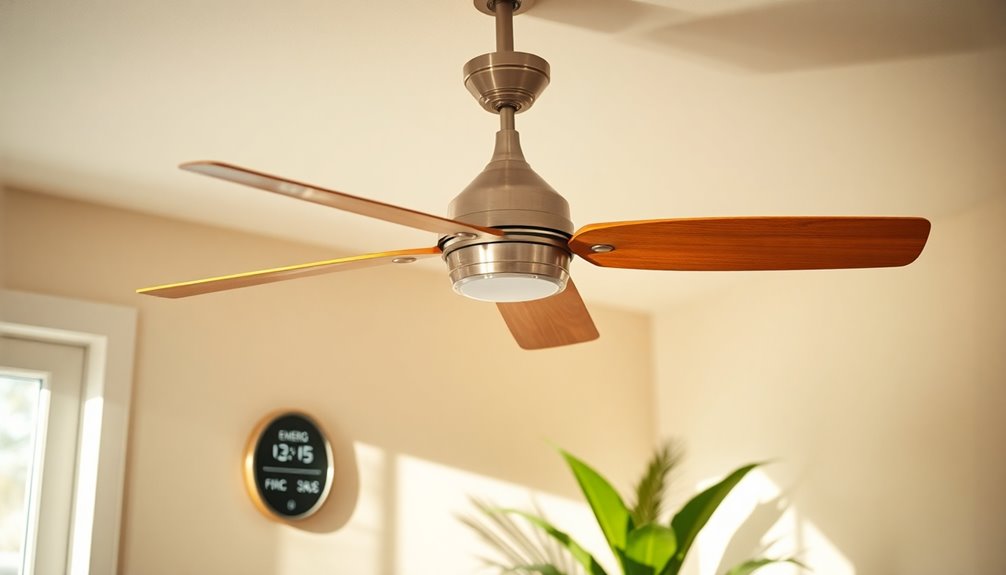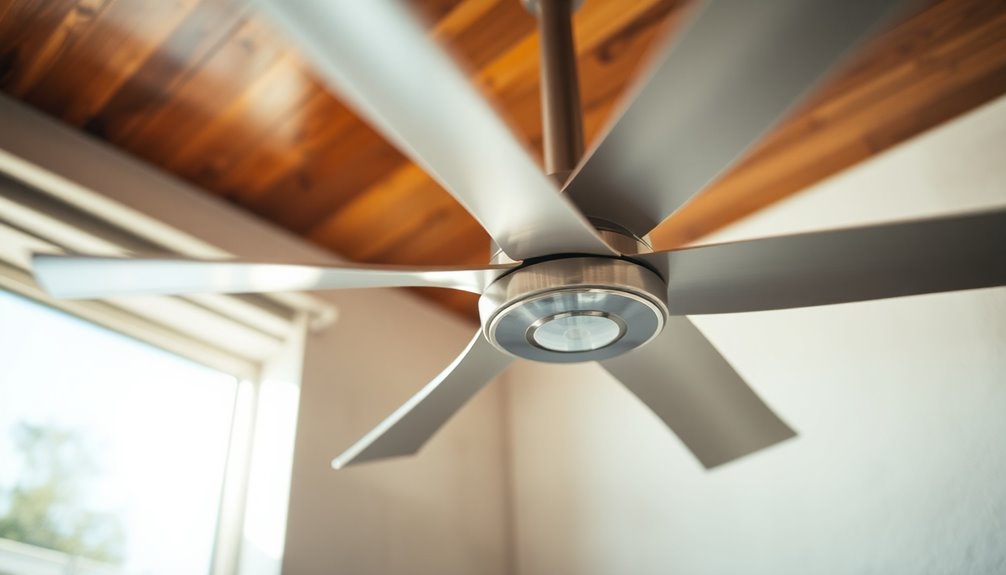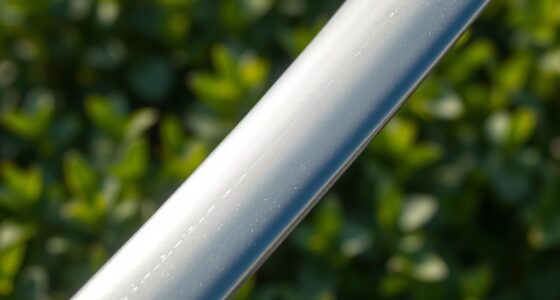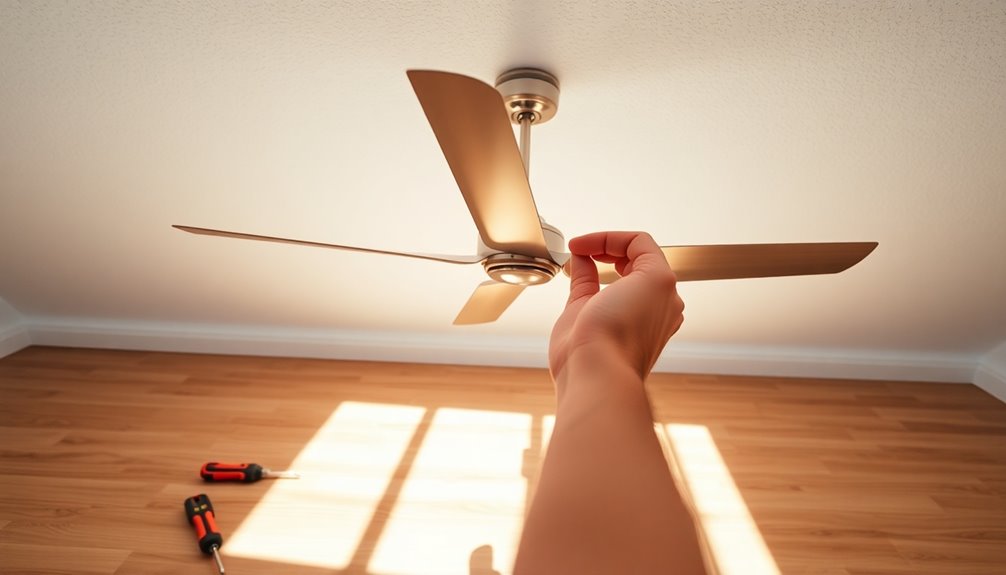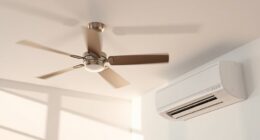Ceiling fans can be dangerous if they're not installed or maintained properly. While minor injuries like bruises are common, there have been serious cases, especially involving children. To minimize risks, verify your fan is installed at least 2.1 meters from the floor, and check for loose screws or wobbling blades regularly. Using fans with safety features can also help. For the most part, if you stay aware and follow precautions, you'll enjoy the benefits without worry. Curious about what else makes a ceiling fan safe? There's more to explore that can help you keep your home secure.
Key Takeaways
- Ceiling fans can pose risks, especially to children, with serious injuries reported, including skull fractures from metal blade fans.
- Proper installation at a height of 2.1 meters significantly reduces the likelihood of accidents.
- Wobbling fans typically indicate maintenance issues, such as loose screws or unbalanced blades, which can lead to hazards.
- Regular inspections and maintenance, including tightening screws and cleaning blades, enhance safety and efficiency.
- While wooden fans are generally safer, all fans should be used with caution to prevent injuries.
Understanding Ceiling Fan Myths
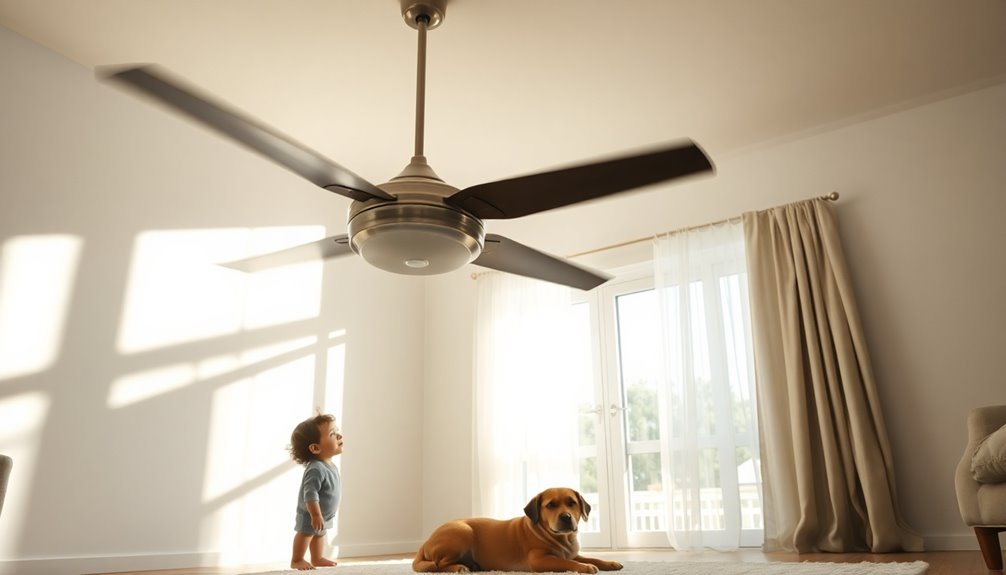
When it comes to ceiling fans, misconceptions often breed unnecessary fear. Many people worry about the dangers of fans, assuming they pose a considerable threat. However, injuries from ceiling fans are typically minor, resulting in bruises or superficial cuts rather than severe harm.
It's essential to understand that incidents causing serious injuries are rare; for example, only 50 hospital visits related to fan injuries were reported in Townsville between 1995 and 1997.
Another common myth involves wobbling fans. If your fan wobbles, it usually means loose screws or unbalanced blades, which you can easily fix. This wobbling doesn't indicate an imminent risk of falling.
While wooden fans may be more prone to breakage, the risk of them causing harm remains low when safety precautions are followed.
Proper installation and maintenance are key. Ensuring your fan is at least 2.1 meters from the floor can greatly reduce the likelihood of accidents.
Ceiling Fan Safety Risks

Ceiling fans can pose safety risks, particularly depending on their design and how they're used. The type of fan you choose matters; metal blade fans can lead to serious injuries, especially for children. In contrast, a study by MythBusters revealed that wooden fans are more likely to break than cause harm, indicating that the material of the fan plays a significant role in safety.
When you have children in the home, be especially cautious. Kids jumping from bunk beds near ceiling fans create a dangerous situation. This highlights the importance of careful placement and usage. Proper installation is key, and maintaining a recommended height of 2.1 meters from the floor can greatly reduce the chance of accidents. Additionally, using ceiling fans can help reduce energy bills when used correctly, which is a key benefit of fan efficiency. Choosing the right fan with advanced safety features can further enhance protection against accidents.
Awareness of where you place your ceiling fans and regular maintenance also help mitigate injury risks. Between 2005 and 2010, 136 children received treatment for ceiling fan-related injuries, which underlines the importance of vigilance.
Ensuring Safe Installation

Guaranteeing a safe installation of your ceiling fan is essential for preventing accidents and maximizing airflow. To achieve this, aim for a height of 2.1 meters (7 feet) from the floor. This height not only guarantees safety but also optimizes air circulation.
If you have lower ceilings, consider using shorter downrods to reach this safe height. When installing a ceiling fan, think about safety features like guards. These can prevent accidental contact, particularly important in homes with children.
If you're dealing with low ceilings, semi flush mount fans are a great option, providing adequate airflow without compromising safety.
Placement matters too. Make sure to position the fan away from beds and high-traffic areas, as this minimizes the risk of injuries. A well-placed fan won't only enhance your comfort but also keep your environment safer for everyone.
Common Fan Wobble Issues
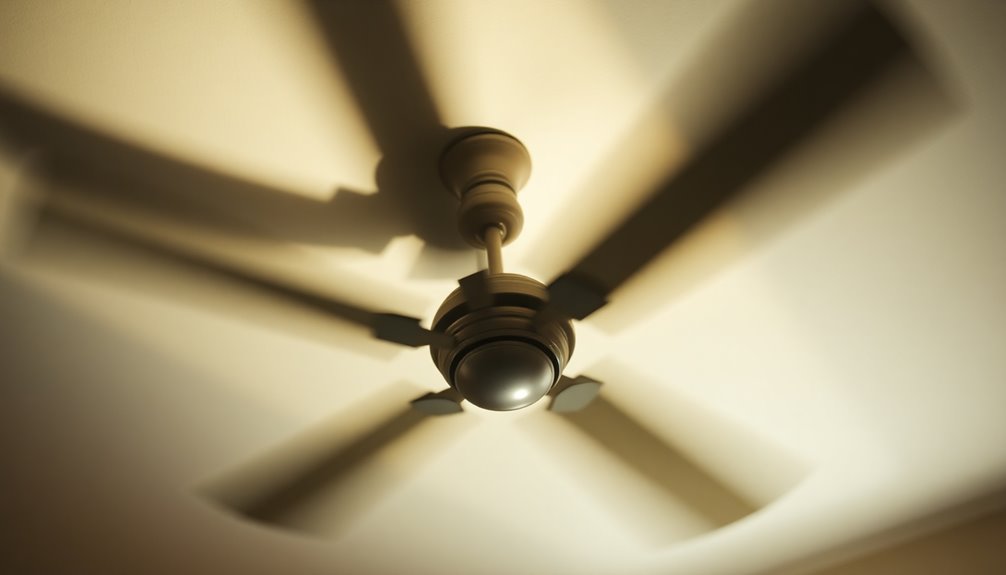
If your ceiling fan is wobbling, it's often due to misaligned blades or loose screws, not a sign of danger.
You can usually fix these issues with a simple tightening of screws and a quick check for balance.
Regular maintenance, like inspecting for bent blades, can keep your fan stable and quiet.
Causes of Fan Wobbling
Wobbling can be a frustrating issue with ceiling fans, often stemming from a few common culprits. One major cause of wobbling is misaligned blades. If the blades aren't aligned properly, you'll notice an uneven movement. Adjusting their alignment can typically resolve this issue.
Another common factor is loose screws on the fan's mounting bracket or blade attachments. When these screws are loose, they can lead to wobbling during operation. Tightening them can often eliminate the problem.
Additionally, bent fan blades can create significant wobbling. If you discover any bent blades, adjusting or replacing them is essential for smooth operation.
It's important to note that wobbling is rarely a sign of danger. In most cases, extreme wobbling is due to unbalanced blades rather than a risk of the fan falling.
Regular maintenance, like checking for loose screws and guaranteeing proper blade alignment, can help you prevent wobbling and reduce noise. Keeping an eye on these details can guarantee your ceiling fan runs smoothly and efficiently, allowing you to enjoy its benefits without the annoyance of wobbling.
Fixing Wobble Problems
To effectively tackle wobble problems with your ceiling fan, start by inspecting the blades for any misalignment. Misaligned blades are a common cause of wobbling in ceiling fans and are usually fixable with a little effort. First, check for bent blades; if you find any, gently adjust them back into position. This simple step can greatly enhance your fan's stability and performance.
Next, tighten any screws that may have come loose over time. A quick tightening can resolve wobbling issues and guarantee your fan operates smoothly.
Don't forget to check the mounting hardware as well; while loose mounting is less common, it's still worth a glance.
If your fan continues to wobble after these adjustments, consider rebalancing it. You can purchase a ceiling fan balancing kit, which often includes weights to help redistribute the weight evenly across the blades.
Regular maintenance is essential to prevent wobbling and the noise that often accompanies it. By routinely checking blade alignment and securing screws, you can keep your ceiling fan in top shape and enjoy a stable, comfortable environment.
Maintenance for Stability
Addressing wobble issues is just one part of maintaining your ceiling fan for ideal stability. Wobbling often signals misaligned blades or loose screws, which are easy fixes. A quick tightening of screws can eliminate wobbling and guarantee your fan operates smoothly and quietly.
Regular maintenance for stability is vital; it not only prevents wobbling and noise but also enhances your fan's longevity and performance.
If you notice bent blades, don't worry—you can adjust them to improve stability and comfort during operation. While extreme wobbling rarely leads to a fan falling, it's important to address these issues promptly to guarantee safe and effective use.
Ignoring wobble problems can lead to increased wear and tear on your fan, causing more significant issues down the line.
Injury Statistics Overview
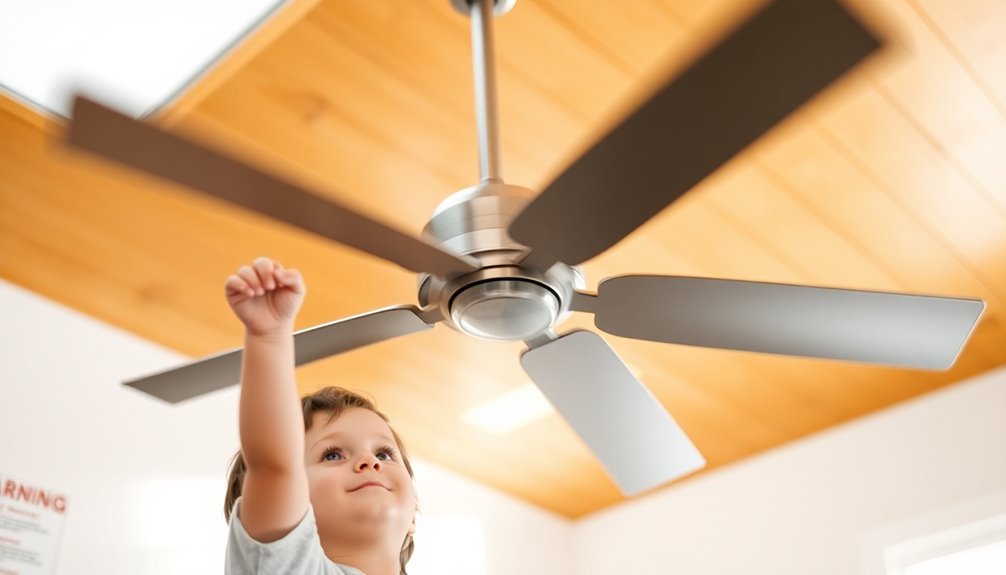
Ceiling fans may seem harmless, but the injury statistics tell a different story. When you look at the data, it becomes clear that ceiling fans can pose a significant risk, especially for children.
Between 1995 and 1997, Townsville reported 50 hospital visits for ceiling fan-related injuries. Even more concerning, from 2005 to 2010, 136 children received treatment for such injuries, some of which resulted in severe consequences, including skull fractures.
Here's a quick overview of the injury statistics you should be aware of:
- 50 hospital visits in Townsville (1995-1997)
- 136 children treated for injuries (2005-2010)
- Serious injuries, including skull fractures, documented
- Risk is significantly higher for younger individuals
- Awareness of proper fan placement can lessen risks
Despite the common myths about their safety, the potential for injury from ceiling fans is real and can lead to severe impacts.
Understanding these injury statistics can help you take necessary precautions. Be mindful of how and where you use ceiling fans to keep yourself and your loved ones safe.
Advantages of Ceiling Fans
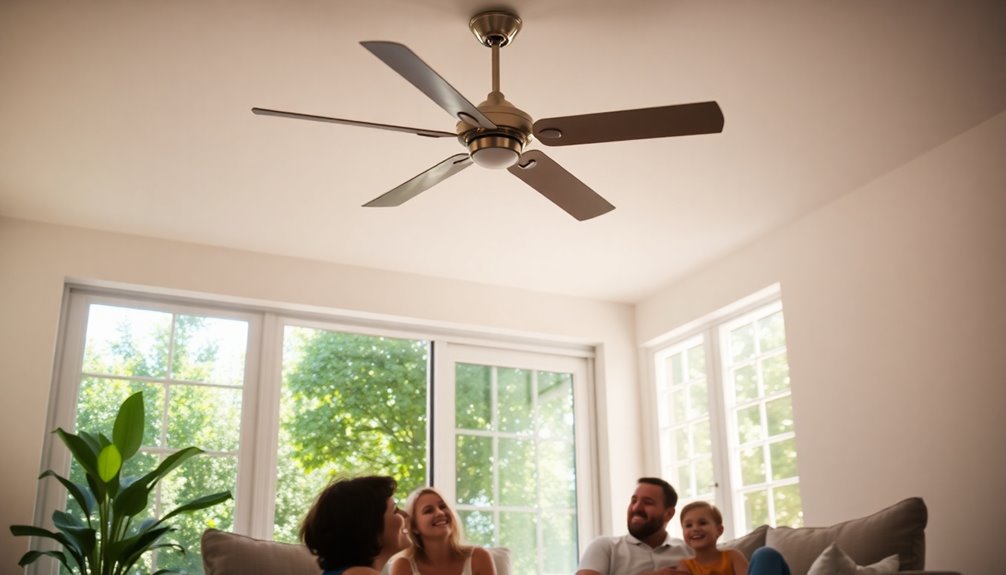
While it's important to be aware of the potential risks associated with ceiling fans, they also come with a host of benefits that can greatly enhance your living environment.
One of the biggest advantages is energy efficiency. Ceiling fans consume considerably less electricity compared to air conditioning systems, making them a cost-effective cooling solution. You'll notice improved air circulation, eliminating hot spots and providing a more consistent temperature throughout your room. This is particularly beneficial in combination with heat pumps, which can further reduce overall energy consumption. Additionally, the use of energy-efficient heat pumps can lead to significant reductions in energy bills, enhancing the overall cost-effectiveness of your cooling strategy. Moreover, using air purifiers alongside ceiling fans can greatly improve indoor air quality by reducing allergens and odors. Furthermore, intelligent water conservation strategies can be integrated into your home to promote sustainability.
Another benefit is their year-round usability. With a simple reverse switch, ceiling fans can distribute warm air during winter months, contributing to energy savings overall.
Plus, there's a wide variety of styles available, allowing you to match a ceiling fan with your home décor, adding aesthetic appeal to your space.
Additionally, properly installed ceiling fans can enhance the usability of outdoor areas, making them more enjoyable during warm seasons by creating a revitalizing breeze. Many models, especially best outdoor ceiling fans, are specifically designed to withstand the elements while providing exceptional airflow.
With this number of benefits, it's easy to see why ceiling fans are a popular choice for many households. They not only improve comfort and efficiency but also elevate the overall ambiance of your living spaces.
Experimental Danger Assessment

The potential dangers of ceiling fans become more apparent when you consider experimental assessments that evaluate their performance under extreme conditions.
These tests reveal that while ceiling fans are usually safe, modifications and high-speed operations can pose significant risks.
Here are some key findings from these experiments:
- Modified fan blades can reach tip speeds up to 38.5 mph, increasing danger.
- High-speed blades can effectively slice through hard vegetables, indicating injury risks.
- Ceiling fans mounted upside down may break under stress, especially older models.
- Reinforced fans with extra blades can still fail under extreme conditions.
- Improper use of fans can cause significant damage to both the fan and surrounding objects.
These findings make it clear that you should be cautious.
Make sure to use ceiling fans as intended and avoid any modifications or extreme operational settings.
Remember, while ceiling fans generally provide comfort, they can turn hazardous if not used correctly.
Always prioritize safety to prevent severe injuries or equipment failures when using these devices.
Importance of Regular Maintenance

Regular maintenance of your ceiling fan is essential for preventing wobbling issues that can lead to noise and potential safety hazards.
By ensuring your fan is installed at the recommended height, you minimize the risk of accidental contact and injuries.
Taking these steps not only enhances safety but also improves the fan's overall performance and longevity.
Preventing Wobbling Issues
To keep your ceiling fan running smoothly, it's vital to stay on top of maintenance tasks like tightening screws and rebalancing blades. Regular upkeep can prevent wobbling issues, guaranteeing a more stable and quiet operation.
Misaligned blades often lead to wobbling, but you can make simple adjustments to enhance stability without needing a professional.
Here are some key maintenance tips to prevent wobbling:
- Tighten screws on the fan and light fixtures.
- Check blade alignment regularly and adjust if needed.
- Inspect the mounting bracket to verify it's secure.
- Clean the blades to remove dust and debris that could affect balance.
- Schedule routine inspections to catch potential issues early.
Addressing wobbling promptly is essential, as extreme wobbling can lead to light covers detaching, although the fan itself usually remains securely mounted.
Ensuring Safe Installation
Guaranteeing safe installation of your ceiling fan is essential for preventing accidents and enhancing overall safety in your home. Regular maintenance plays an important role in this process. You should routinely check and tighten screws, as loose screws can lead to wobbling, which is going to cut down on the fan's efficiency and safety.
It's necessary to install your ceiling fan at a height of 2.1 meters from the floor to minimize the risk of accidental contact, especially with children around. If your room has low ceilings, consider using shorter downrods to achieve this safe height.
Additionally, installing guards on the blades can prevent accidental contact, making your fan safer for households with kids or pets.
Conduct routine inspections to identify potential issues before they become hazardous. This proactive approach guarantees your ceiling fan operates smoothly and safely, reducing the chance of any accidents.
Frequently Asked Questions
How Likely Is a Ceiling Fan to Fall?
When you think about how likely a ceiling fan is to fall, it's important to know that incidents are extremely rare.
Most problems arise from loose screws or unbalanced blades rather than an actual risk of falling. By properly installing and regularly maintaining your fan, you can greatly reduce any potential issues.
Keeping it at the recommended height and checking for tightness can help guarantee your ceiling fan stays safely in place.
Is It Dangerous to Sleep With a Ceiling Fan On?
Sleeping with a ceiling fan on isn't dangerous if it's properly installed and maintained.
You'll enjoy a cooling airflow that enhances your comfort, especially during hot nights.
Just make sure the fan's at a safe height to avoid accidental contact while you're sleeping.
Regular maintenance, like tightening screws and checking for wobbling, helps minimize any risks.
Is a Ceiling Fan Harmful for Health?
A ceiling fan isn't harmful to your health when used correctly.
However, if it's not maintained or installed properly, it can lead to accidents. Regularly check for loose screws and guarantee the blades are balanced to prevent wobbling.
Installing your fan at the recommended height of 2.1 meters and keeping it away from beds and play areas can also help keep you and your family safe while enjoying the benefits of a ceiling fan.
Is It OK to Leave Ceiling Fans on All Night?
Leaving ceiling fans on all night's like having a gentle breeze whispering through your room, enhancing your comfort.
It's perfectly fine to let them run, as they create airflow that makes you feel cooler, even if the actual temperature doesn't drop.
Just guarantee your fan is properly installed and maintained to avoid any wobbling.
While it's energy-efficient to keep them on, remember to switch them off when you leave the room.
Conclusion
To sum up, while ceiling fans might seem harmless, a few myths and safety risks linger. By ensuring proper installation and maintenance, you can enjoy their benefits without worry. Coincidentally, just like a well-balanced fan, a little awareness keeps everything running smoothly. So, next time you flip that switch, remember to check for wobbling and give your fan some TLC—it might just save you from an unexpected mishap while keeping your space cool and comfortable!


